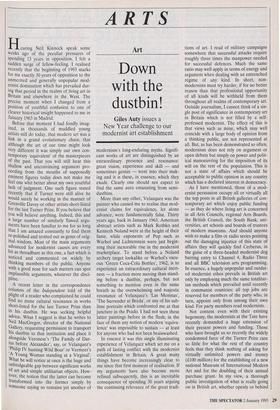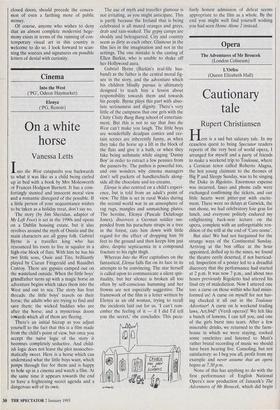ARTS
Art
Down with the dustbin!
Giles Auty issues a New Year challenge to our modernist art establishment
earing Neil Kinnock speak some
H
weeks ago of the peculiar pressures of spending 13 years in opposition, I felt a sudden surge of fellow-feeling. I realised recently that the beginning of 1993 marks for me exactly 30 years of opposition to the unmerited and generally unpopular mod- ernist domination which has prevailed dur- ing that period in the realms of living art in Britain and elsewhere in the West. The Precise moment when I changed from a Position of youthful confusion to one of clearer historical insight happened to me in January 1963 in Madrid.
. Before that moment I had fondly imag- ined, as thousands of muddled young artists still do today, that modern art was a link in a grand evolutionary chain; that although the art of our time might look very different it was simply our own con- temporary 'equivalent' of the masterpieces of the past. That you will still hear this shallow and unconvincing argument pro- ceeding from the mouths of supposedly eminent figures today does not make me feel one whit better about my own youthful lack of judgment. One such figure stated recently that if Turner were still alive he would surely be working in the manner of Grenville Davey or other artists short-listed for the last Turner Prize. If you believe that You will believe anything. Indeed, this and a large number of similarly flawed argu- ments have been familiar to me for so long that I am amazed constantly to find them re-polished and trotted out as gems of orig- inal wisdom. Most of the main arguments advanced for modernist causes are every bit as threadbare as this one, a fact which is noticed and commented on widely by thinking members of the public. Anyone With a good nose for such matters can spot implausible arguments, whatever the disci- pline.
A recent letter in the correspondence columns of the Independent told of the plight of a reader who complained he could find no more cultural resonance in works short-listed for the last Turner Prize than in his dustbin. He was seeking helpful advice. What I suggest is that he writes to Neil MacGregor, director of the National Gallery, requesting permission to transport his dustbin to that institution and place it alongside Veronese's 'The Family of Dar- ius before Alexander', say, or Velazquez's ,Philip IV hunting Wild Boar' or Vermeer's A Young Woman standing at a Virginal'. What he will notice at once is the huge and unbridgeable gap between significant works of art and simple utilitarian objects. How- ever, the notion that the latter can become transformed into the former simply by someone saying so remains yet another of
modernism's long-enduring myths. Signifi- cant works of art are distinguished by an extraordinary presence and resonance: great vision, experience and skill — and sometimes genius — went into their mak- ing and it is these, in essence, which they exude. Clearly one should not expect to find the same aura emanating from semi- dustbins.
More than any other, Velazquez was the painter who caused me to realise that mod- ernist claims for equivalence, let alone advance, were fundamentally false. Thirty years ago, back in January 1963, American abstract artists such as Mark Rothko and Kenneth Noland were at the height of their fame, while exponents of Pop such as Warhol and Lichtenstein were just begin- ning their inexorable rise in the modernist marketplace. To stand before a Noland archery target lookalike or Warhol's vacu- ous 'Green Coca-Cola Bottles', 1962, is to experience an extraordinary cultural inert- ness — a fraction more moving than stand- ing before a dustbin, perhaps, but not something to mention even in the same breath as the overwhelming and majestic resonance of Velazquez's 'Las Meninas', 'The Surrender at Breda', or any of his sub- lime portraits which confronted me at that juncture in the Prado. I had not seen these latter paintings before in the flesh; in the face of them any notion of modern 'equiva- lence' was impossible to sustain — at least for anyone who had not been brainwashed.
In essence it was this single illuminating experience of Velazquez which set me on a path of lasting conflict with the modernist establishment in Britain. A great many things have become increasingly clear to me since that first moment of realisation. If my arguments have also become more refined subsequently, this is an inevitable consequence of spending 30 years arguing the continuing relevance of the great tradi- tions of art. I read of military campaigns somewhere that successful attacks require roughly three times the manpower needed for successful defences. Much the same ratio may well apply in terms of energy and argument when dealing with an entrenched regime of any kind. In short, non- modernists must try harder, if for no better reason than that professional opportunity of all kinds will be withheld from them throughout all realms of contemporary art. Outside journalism, I cannot think of a sin- gle post of significance in contemporary art in Britain which is not filled by a self- professed modernist. The effect of this is that views such as mine, which may well coincide with a large body of opinion from a thinking public, are not represented at all. But, as has been demonstrated so often, modernism does not rely on argument or open debate but simply on power and polit- ical manoeuvring for the imposition of its will on the rest of the population. This is not a state of affairs which should be acceptable to public opinion in any country which has a declared interest in democracy.
As I have mentioned, those of a mod- ernist persuasion occupy all or virtually all the top posts in all British galleries of con- temporary art which enjoy public funding — as they do where living art is concerned in all Arts Councils, regional Arts Boards, the British Council, the South Bank, uni- versities, art schools and boards of trustees of modern museums. And should anyone wish to make a film or radio series pointing out the damaging injustice of this state of affairs they will quickly find Cerberus, in the guise of a three-headed modernist dog barring entry to Channel 4, Radio Three and all BBC television arts programming. In essence, a hugely unpopular and outdat- ed modernist ethos prevails in British art only by employing much the same totalitar- ian methods which prevailed until recently in communist countries: all top jobs are reserved for members of the party who, in turn, appoint only from among their own kind. For party members read modernists.
Not content even with their existing hegemony, the modernists at the Tate have recently demanded a huge extension of their present powers and funding. Those who have brought us so recently the widely condemned farce of the Turner Prize care so little for what the rest of the country feels that they think nothing of asking for virtually unlimited powers and money (£100 million) for the establishing of a new national Museum of International Modern Art and for the doubling of their annual purchase grant. In my view, a thorough public investigation of what is really going on in British art, whether openly or behind closed doors, should precede the conces- sion of even a farthing more of public money.
Of course, anyone who wishes to deny that an almost complete modernist hege- mony exists in terms of the running of con- temporary visual art in this country is welcome to do so. I look forward to scan- ning the sources and signatures on possible letters of denial with curiosity.











































 Previous page
Previous page